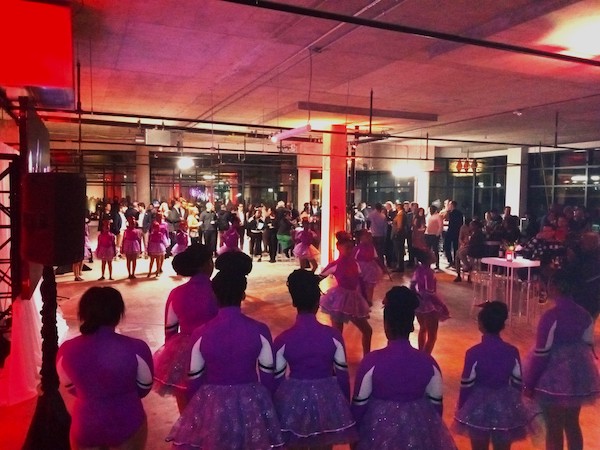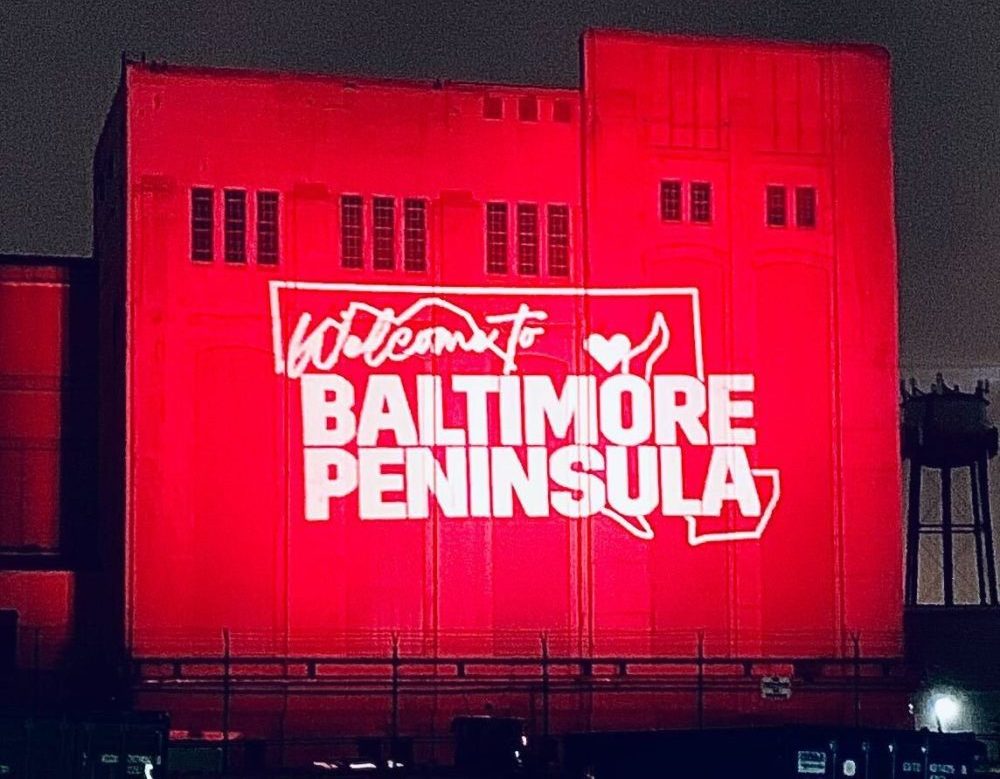The 235-acre mixed-use development, formerly known as Port Covington, now includes five new buildings ready for leasing. Investors and developers are working to make Baltimore Peninsula, amounting to over 1 million square feet, an icon of an ascending, inclusive Baltimore.
In tandem with this aim, those who came to Rye Street Tavern on Tuesday night persevered through the precipitation to enjoy cocktails, hors d’oeuvres, club music and presentations by dignitaries.
The mood of the gathering was upbeat, as was the momentum the project is building under its new name. This stood in contrast with the public controversy, turnover and delays the project had endured since its initial proposal in 2016.
MAG Partners is a major partner in Baltimore Peninsula. Its vice president of leasing, Scooter Monroe, said the new space can host the needs of various tenants — from 2,000 square feet of boutique space to 100,000 square feet for business infrastructure — for a larger footprint.
“We’ve been talking to financial institutions, tech companies — we have different-sized spaces for all types of tenants,” he said. “It’s all dependent on the market. We’re breaking up some of our floors to be small suites that are dedicated for small tenants, but if someone wants to take a whole floor — or whole building — we can absolutely do that as well.”

Baltimore Peninsula’s other principal partners include MacFarlane Partners, Sagamore Ventures and the Urban Investment Group within Goldman Sachs. The South Baltimore development had initially grown out of work by Baltimore-homegrown billionaire Kevin Plank, executive chairman of Under Armour and Sagamore Ventures’ CEO.
Plank had taken advantage of federal tax incentives made possible by the Trump administration for low-income urban areas. Baltimore Peninsula’s development sits on land that was largely considered undeveloped, with many other areas of the city being more populated with fewer resources. But the Baltimore City Council approved a $660 million tax-increment financing deal to help with the project back in 2016.
Plank and the other developers are also working with Jones Lang LaSalle (JLL), a global commercial real estate service firm headquartered in Chicago. Monroe said the partners are currently working with two potential tenants, who have each expressed interest in 100,000 square feet of space in Baltimore Peninsula.
In addition, the architecture and interior design firm H. Chambers Company signed on to occupy 9,000 square feet of space over a 10-year lease. It will move to Baltimore Peninsula in March of 2023.
But Baltimore Peninsula is designed as more than a commercial destination. 416 residential apartment units are expected to become available at two of the residential facilities (named Rye House and 250 Mission) in Q1 of 2023, with the first renters arriving in March. Around 21% percent of the units will be earmarked for affordable housing; 35 units in one facility and 54 units in the other will be earmarked for households earning 80% and 50% of the median family income, respectively. The last of these residential buildings, 2400 Terrapin Way, is expected to launch in January and include 120 units — 81 of which are extended stay.

Ron Weich, dean of the University of Baltimore’s School of Law, described the project as a “very important development for the city.”
“Baltimore is on the verge of great things and this is right at the heart of it,” he said. “People should be moving here from Washington DC, Philadelphia. We want to grow. We need more population. I just think you’re going to see all kinds of activity here that’s going to be really attractive.”
Another legal professional in attendance was Jon Laria, the managing partner of Ballard Spahr’s Baltimore office. He said the national law firm has been handling much of the Baltimore developers’ legal needs since the beginning.
“I don’t think anyone’s done anything this big in Baltimore,” he said. “I think the integration of the project team and the surrounding community with this enormous investment is really unprecedented.”
The event’s branding suggested that the project’s partners are working to make community inclusivity, at least in part, a focus of Baltimore Peninsula.
Students from The Carroll School of Dance in Northeast Baltimore performed for those gathered. A DJ immersed the space in uptempo club music.
Nate Alston, an accountant at PricewaterhouseCoopers, spoke at the event on behalf of the CollegeBound Foundation scholarship program. The foundation helps Baltimore City Public Schools students pay for college, and its board primarily consists of people working in the investment and educational sectors.
“Getting these scholarships from College Bound allowed me to go to school,” he said. “I basically just came back to tell a little about my story.”
The accountant said he saw an opportunity for Baltimore residents with the opening of Baltimore Peninsula.
“I feel like it’s definitely inclusive,” he said. “I don’t have any concerns for [nearby] neighborhoods. I just hope it brings more job offers to neighborhoods, so they can work in some of the buildings. Let’s really hope it’s low-income and affordable for everyone to live here. It definitely looks like a little town.”

Laria also suggested that the project will have a positive, not displacing, impact on the local landscape.
“There was nothing here,” he said. “We took this land that had nothing on it. There’s no displacement whatsoever, and no gentrification.”
Baltimore Peninsula partners stated in a release that it has committed more than $132 million to contracts with city-certified so-called Minority Business Enterprise (MBE) and Women’s Business Enterprise companies. According to the investment partnership, that outpaces initial goals of 35% participation for MBEs and 13% for WBEs. The developers also partnered with Sweeten on a diversity-minded vendors dashboard.
A smaller initiative, Project JumpStart, was created with Sagamore Ventures’ support to finance the on-the-job education of 22 Baltimore students. The investment firm and its partners also seek $50 million help minority- and women-owned innovation firms who wish to create a more equitable society.
Much of Baltimore Peninsula’s future may depend on its investors’ ability to attract tenants. Five buildings are up and available, with plenty of room to grow. Its location, on the waterfront and adjacent to major highways, is also significant.
The city, as well as the wider investment community, has put sweat equity and hard currency into the project for over a decade. Now, it’s time for those most invested in the project to make their dream a profitable reality and perhaps create new community opportunities.
Several of those gathered for the celebration ultimately anticipate happier horizons for the city.
“It’s really, really exciting stuff, so people should come to see it for themselves,” Laria said, “It’s great. It’s great to see the buildings here.”







